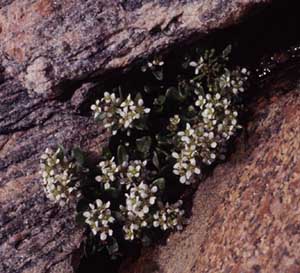|
The scurvy grass (photo to the
right) could in early springs show their small white fragrant flowers
already at the end of March. But the flowering period is extended and flowers can often be seen well into June.
The rounded, fleshy, fresh green leaves, which also stays green in winter, are rich in vitamin C. Seamen who formerly went ashore along the North Atlantic coasts would often eat these leaves, to reduce the risk of suffering from scurvy (ie lack of vitamin C) during their stay at
sea.
This species usually has a two year life-cycle. The first year the plant develops its green
leaves. The second year, flowers develop on the shoots. After flowering and
ripening of the seed, the whole plant die.
|
 |
